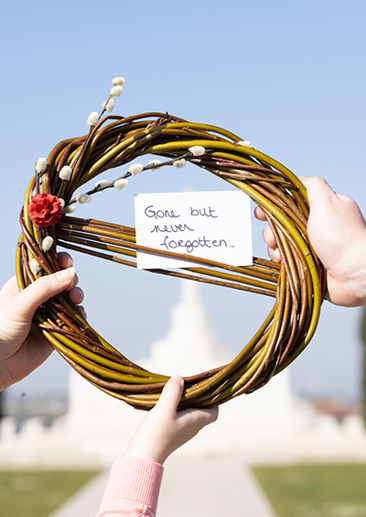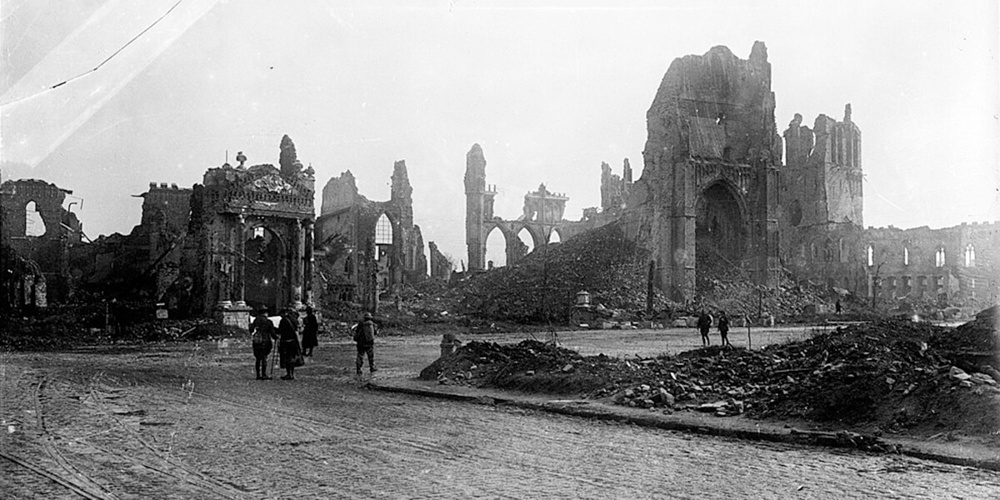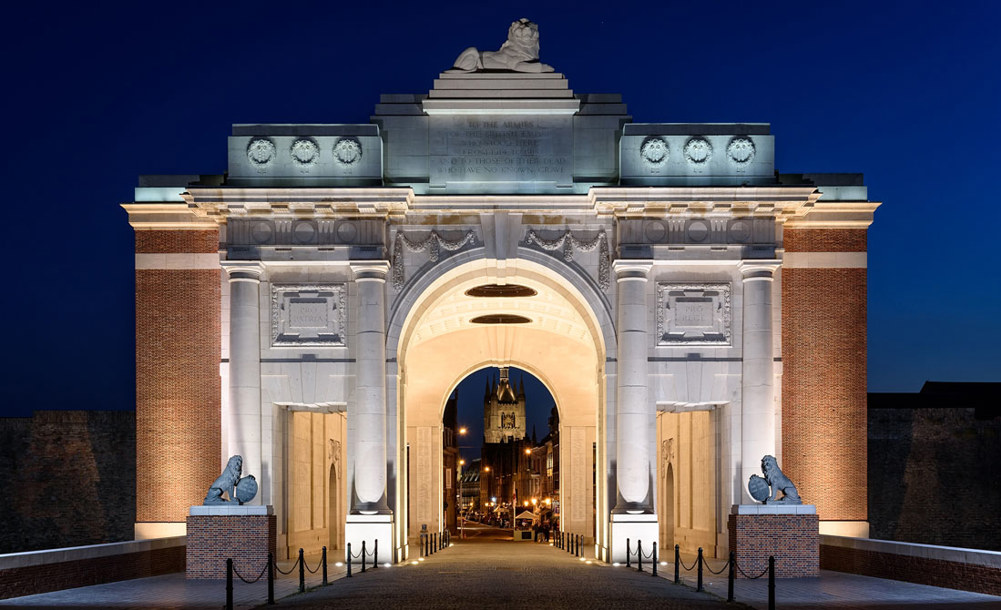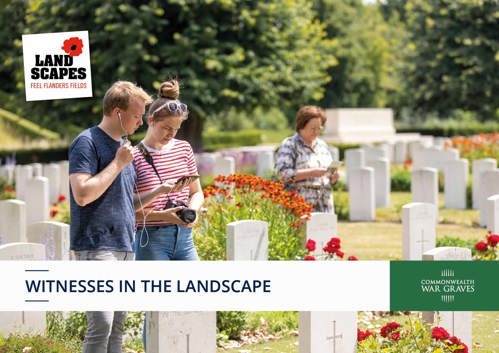Visit the CWGC in Ieper, Belgium
The town of Ieper, also known as Ypres, West Flanders, is an area that saw intense fighting throughout the First World War. Known to the British troops based there during the war as ‘Wipers’, the town is intrinsically linked with the war.
Visit the CWGC Ieper Information Centre

The CWGC Ieper Information Centre is in the centre of town, just a stone’s throw from the iconic Menin Gate. The centre is the perfect starting point when visiting any of the cemeteries and memorials that commemorate those that fell during World War One.
Drop in and our friendly team will help you find out more about CWGC’s local sites, undertake research on the CWGC database or answer questions you may have about our work. You can also pick up a souvenir from the CWGC shop or join our membership scheme.

Purchase a wreath or a CWGC souvenir
Our small, medium and large biodegradable wreaths are available at the CWGC Information Centre next to the Ypres (Menin Gate) Memorial. They can also be found at three new locations in the Ypres Salient: Talbot House in Poperinge, the Memorial Museum Passchendaele 1917 in Zonnebeke and the Hooge Crater Museum in Ieper!
Each wreath is carefully and respectfully handmade in the former Ypres Salient from woven fresh willow that grows on the former battlefields.
They contain a gorgeous blend of brown and greenish twigs that over time will dry-out to become a beautiful uniform colour. Soft willow catkins provide a touch of white that will never fade, symbolising our commitment to never forget the lives which were lost during the World Wars. A single red flower provides the finishing touch, a colourful glint amongst the headstones.
OUR OPENING TIMES
The Ieper Information Centre is currently closed, but will reopen later this year.
Stay tuned for exciting news ahead of our reopening!
On significant days when specific important historical events are commemorated, extended opening hours are possible.
FACILITIES
A gift shop is available at the centre. There is a multi-language service available, offering information and brochures about the Commonwealth War Graves Commission and the numerous sites to visit in the area.
You can also freely access our casualty database via iPad to help you find the location of graves of your interest.
We are committed to providing an accessible attraction, and we strive to ensure that visitors with disabilities can enjoy as much of our centre as possible. If you have any questions, or to arrange any additional support for your visit please email enquiries@cwgc.org or call us on +44 (0) 1628 507200.
Travelling to Ieper
Our address is:
The Commonwealth War Graves Commission Ieper Information Centre
Menenstraat 33
8900 Ieper,
Belgium
| The best ways to get to us: | |
|
BY CAR: From Lille: take the A25 to exit 13 and join the D948. From Calais: take the A16 to Dunkirk and Lille and pick up the Lille route. |
BY TRAIN: Eurostar from London to Lille or Brussels. From Brussels, trains run hourly to Ypres with a change in trains in Ghent. From Lille Europe you would need to change stations to Lille Flanders (by foot) and change trains as well in Kortrijk. |
|
BY FERRY/CHANNEL TUNNEL: Ferry services to Calais, Le Shuttle service to Calais. |
BY AIR: Lille airport in Lesquin or Brussels International. |
Find us - Ieper Belgium Map
The history of Ieper

Ypres was a key strategic point in the front lines having been captured by British troops during the opening months of the war. This advance caused a bulge in the line, known as the Ypres Salient, which was the site of many of the fiercest battles of the war.
Today, the town has been rebuilt but still retains its ties to the war. Ieper is home to the iconic Menin Gate Memorial to the Missing and a number of other CWGC war cemeteries and memorials throughout the region.
Where is Ypres?
Ypres, or Ieper, is a small city in the province of West Flanders, Belgium.
The city is close to the France-Belgian border and was the last line of defence against the German push to the French ports of Calais and Dunkirk, which were a vital part of the supply lines between Britain and the Western Front.
Why is Ypres called Ieper?
Simply put, Ypres is the French language name for the town, and Ieper is the Dutch language name for the town.
Today, Ieper is the official name, but during World War One, British soldiers would use Ypres, although anglicised to “Wipers” - as notably demonstrated by the soldiers’ publication ‘The Wipers Times’.
Ypres and WW1
The battles at Ypres and the surrounding areas have become synonymous with the trench warfare that typified the fighting on the Western Front.
The First Battle of Ypres began in October 1914, as the opposing forces attempted to outflank one another, with neither side able to gain a decisive advantage. The German forces wanted to push through Belgium and into northern France, whilst the Allied troops armies sought to hold the channel ports and preserve their important supply routes with the United Kingdom. The battle drew to a stalemate as the weather worsened, ending on 22 November 1914, although a few ineffective operations were launched throughout the winter months.
The Second Battle of Ypres began in April 1915 when German forces attacked Allied lines in the north of the Ypres Salient, an area where Allied lines were surrounded on three sides by German-held territory. The battle was notable for one of the earliest uses of poison gas by German forces. The Allied defenders were pushed 3 miles closer to Ypres, although they retreated a German breakthrough did not materialise.
The Third Battle of Ypres, also known as the Battle of Passchendaele, began in July 1917, lasting for more than three months before it ended in November 1917. In what was one of the bloodiest battles of the war, the Allies made an initially successful assault, before becoming bogged down by bad weather and strong German defences. In drier weather in September and October, British Empire forces achieved success with limited attacks intended to ‘bite and hold’ German lines. South African, Australian, New Zealand and Canadian forces would all play an important role.

German forces suffered heavy casualties during the battles of the Menin Road Ridge, Polygon Wood and Broodseinde. In October, heavy rain returned and turned the battlefields into a muddy morass during further fighting at Poelcappelle and Passchendaele. The offensive was finally halted after the capture of Passchendaele in November, and the village would lend its name to popular descriptions of the battle.
Throughout the long years of fighting, the city of Ypres - including its historic cathedral and Cloth Hall - was turned to rubble by German artillery. In 1920, King George V awarded the Military Cross to the city, which also recieved the French Croix de Guerre. While the city has since been rebuilt, the scars of the Great War are still evident, with many cemeteries, memorials and monuments to those that died.
Ieper war memorials
Such was the ferocity of the fighting around the Ypres salient, that many of our largest and most well known cemeteries and memorials can be found in or nearby Ieper.
One of the most famous war memorials in the world, the Ypres Menin Gate, is a key part of the city and home to the nightly Last Post service, where residents and visitors to the city pay tribute to all those who died during the war.
The CWGC’s New Irish Farm cemetery, Hooge Crater Cemetery and Bedford House Cemetery are located on the outskirts of the city, all of which hold thousands of First World War casualties, and the Tyne Cot Cemetery and memorial can be found just a short drive from the city.

Ieper, seen through the Menin Gate at night, (photo: Dirk Debleu)
YPRES (MENIN GATE) MEMORIAL RESTORATION
The iconic Menin Gate Memorial is currently undergoing an extensive restoration programme in readiness for its centenary in 2027.
EXPLORE CWGC IEPER / YPRES WAR GRAVES AND SITES
The trench warfare around the Ypres Salient cost thousands of lives on both sides. Many of our largest cemeteries and memorials can be found in the Flanders region. Some of the closest sites to the town are:

The Ypres Menin Gate Memorial
The Menin Gate in Ieper is one of the most famous war memorials in the world. Unveiled on 24 July 1927, the memorial bears the names of more than 54,000 men and officers from around the Commonwealth who died in the region and have no known grave.
Learn more about the Menin Gate Memorial
New Irish Farm Cemetery
Located to the north-east of the town, New Irish Farm cemetery is the final resting place of more than 4,700 Commonwealth servicemen of World War One who were brought to the site from battlefield burials and smaller cemeteries in the region.
Learn more about New Irish Farm Cemetery
Hooge Crater Cemetery
Named after the nearby Hooge Chateau and a crater caused by a mine explosion, Hooge Crater Cemetery is located in an area that saw incredibly fierce fighting throughout the duration of the war. Close to 6,000 World War One burials can be found here, more than half of which remain unidentified.
Learn more about Hooge Crater Cemetery
Bedford House Cemetery
There are more than 5,000 World War One burials at Bedford House Cemetery, as well as 69 World War Two burials. It is named after the Chateau Rosendal, which was named Bedford House by Commonwealth troops stationed nearby.
Learn more about Bedford House Cemetery
WESTTOER
Build your own Flanders pilgrimage. Browse the local cemeteries and memorials in the Ypres salient or try our themed recommendations.
Things to do in Ieper
As well as its ties to the world wars, Ieper has a rich cultural and historical character. There is a huge array of places to see and things to do in Ypres:








